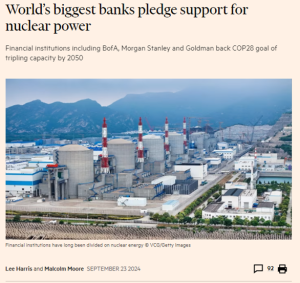P.S. – If you would like to receive weekly updates like this, sign up here.
Dear Readers,
So, all the buzz surrounding artificial intelligence (AI) is like, so last year, isn’t it?
Not so long ago, everywhere you turned, everything you read, was just about AI, or something linked to it.
But it seems to have gone strangely quiet in the last few weeks.
Which is quite the turnaround.
Now, as part of my job, I stay very close to the markets in regards AI-related stocks. But even to normal everyday folk who only have but a cursory glance at the stock market every now and then, I’m pretty certain one particular stock would be well known.
That stock, of course, is called Nvidia.
You simply were never even in the game of trading or investing if you didn’t have some exposure to this particular stock’s meteoric rise this year at least.
Until this week. No longer is Nvidia the number one performing stock in the US. No, it’s been replaced.
And not by another AI giant…but by Vistra Corporation. An electricity supplier across the United States.
And that electricity is provided by – nuclear power.
Begs the question, doesn’t it? Are you a Vistra Corp investor?
Easy to say in hindsight, but with a little knowledge of the land markets and the 18.6-year cycle, you could very well have been!
Read on now as I show you why these two sectors are likely to be the next great trend in markets, surpassing even AI.
Banks have steered clear of this industry – until now.
The story starts with this very recent news article from Morningstar.
Vistra Corp. shares (VST) overtook Nvidia Corp. shares (NVDA) last week to become the top performer in the S&P 500 SPX on a year-to-date basis. That’s an impressive feat for an electricity provider that’s hardly a household name.
Through Friday’s close, shares of Vistra were up 180% on the year, while shares of Nvidia were up 134%. Shares of Constellation Energy Corp. (CEG), another play on nuclear power, ranked third with a 118% year-to-date gain.
Earlier this year, one of the best performing commodities in terms of price appreciation was uranium. Over the last few months, the heat has come out of the market, and it’s undergone a period of consolidation.
And with that, the uranium spot price also dropped.
It is at this juncture that a truism about the stock markets once again proves its wisdom: that is, that the stock market’s job is to discount future events today into a tradable price. No other forecasting engine that humanity has created can come close to replicating this ability.
I had a suspicion that something else was moving this (uranium) market. I was not of course privy to it, but I knew this much.
In 6 to 12 months’ time the reason why such a strong move had begun would be public knowledge. I just needed to be patient and keep my eyes peeled for it.
And three days ago, I believe I have discovered that news. And with it, a renewed move higher for all uranium exposed stocks.
From the above article.
Fourteen of the world’s biggest banks and financial institutions are pledging to increase their support for nuclear energy, a move that governments and the industry hope will unlock finance for a new wave of nuclear power plants.
At an event on Monday in New York with White House climate policy adviser John Podesta, institutions including Bank of America, Barclays, BNP Paribas, Citi, Morgan Stanley and Goldman Sachs will say they support a goal first set out at the COP28 climate negotiations last year to triple the world’s nuclear energy capacity by 2050.
They will not spell out exactly what they would do, but nuclear experts said the public show of support was a long-awaited recognition that the sector had a critical role to play in the transition to low-carbon energy.
Ah yes, the old climate change trope is being rolled out.
Frankly, they are correct; no viable solution to reducing dependency on fossil fuels can ever happen without nuclear power providing that important bridging capacity so we can all maintain our current standards of living.
But this newsletter isn’t about climate change, nor how best to achieve it.
It’s about certain US listed companies whose future is delicately interdependent on one another. To truly understand why, you must accept this absolute truth.
It’s all about land.
Always place this at the heart of your research.
Believe me, by placing the subject of land at the centre of everything you do, an entirely different way of viewing the world opens up to you.
It also leads me to a potentially very lucrative new trend you can follow. Only if you can see it.
In almost every country you can think of, nuclear power is a touchy subject. Historically, the big banks prefer to stay clear as it upsets shareholders and adds further government scrutiny into their business dealings.
Plus, there’s a political cost for the CEOs of these banks and their career advancements should they sign off on any finance. However, this has begun to change. Big banks and major government policy makers have found their collective narrative: climate change.
By being seen to be working “with” governments, rather than “against” them, these banks have found fertile new ground to increase market share, and politicians have the vote-winning finance to take to re-election on a climate change platform.
However, the article betrays somewhat another possible reason for the banks’ change of heart.
Nuclear energy has also started to gain support from Big Tech, which sees it as one low-carbon solution to powering data centres.
On Friday, Microsoft announced a 20-year deal with Constellation Energy to restart an 835-megawatt nuclear reactor at Three Mile Island in Pennsylvania that was in the process of being decommissioned.
Larry Ellison, co-founder and chief technology officer of Oracle, said this month that the company was designing a huge data centre with “permits for three . . . small modular nuclear reactors”.
What do these data centers reside on? What do these new modular nuclear reactors need? They need land.
Here is where a potential mega-trend is forming. And it’s already started, with the largest ever data centre deal.
Blackstone Australia head of real estate Chris Tynan last week oversaw the $24 billion acquisition of operator AirTrunk, which own 11 data centres across Australia and Asia. Chris Tynan said what drove the opportunity was its ability to follow the power.
Quote: “Power is absolutely the constraint,” Mr Tynan said. “For AirTrunk, their relationships with the vertical supply chain and, frankly, their ability to go out and, substation by substation, identify where the power is overbuilt, or where it’s likely to have some capacity, has been an identifying feature and a unique feature of their management capability.”
In other words, the world demands more data centers and does not have the power capacity or infrastructure to meet this demand.
The biggest and most important tech giants on earth are using their vast treasure chests of cash to grab market share of some of the most valuable land on earth. If these data centers don’t have on-tap and virtually unlimited access to power as and when needed, then the vast sums spent to acquire them will not prove to be a good investment.
Nuclear power instantly solves this, allowing these tech giants to secure more processing and storage capacity for increasingly complex artificial intelligence and cloud computing.
This is the key to completely unlock the true power of the upcoming AI revolution. And what ultimately ends up capturing all these gains once they manifest?
This is why land is so important. This is why you must research its history and appreciate its importance within an overall 18.6-year Real Estate Cycle. This business about big banks backing nuclear energy has nothing to do with climate change.
Here’s a fact; no government has EVER met its own mandated climate change targets.
Here’s another fact; no government EVER WILL meet its own mandated climate change targets. As a CEO of one of these banks ready to deploy tens of billions of dollars’ worth of new credit, this would represent a very poor bet to make.
What has attracted them however is grabbing market share of some of the most valuable collateral on earth. The same land that these data centres and nuclear power plants sit on.
Is this a new mega-trend? Time will tell but consider this: all this new bank credit could only happen NOW, not before, even two to three years ago. The reason why so much money is needed is due to the price of land.
What’s the future for land prices? How long could this trend last for? How much time might you have left to take advantage of this knowledge?
Become our newest Boom Bust Bulletin (BBB) member and discover for yourself. Build your own market edge and discover opportunities like this one by immersing yourself in the history of the real estate cycle, why it continues to repeat even after over 200 years of history.
For just $4 (USD) a month you’ll be given a front-row seat to all the latest developments pertaining to the cycle. It’s knowledge only a select handful of market participants will ever possess.
The hot air has now rapidly deflated out of the AI hype bubble. The recent earnings season in the US torpedoed any hope Johnny comes lately investors had of continuing growth here. Almost every AI exposed company reported the same thing.
They are years away from making even a single dollar of profit out of AI. In fact, the short-term story is one of intense and expensive capital investments.
By now you should know what those capital expenditures must be.
Here is yet another example of how studying the land markets can lead you to the “true” opportunities out there.
And steer you clear of the hype.
Best wishes,
|
|
P.S. – If you would like to receive weekly updates like this, sign up here.
P.P.S – Find us on Twitter here and go to our Facebook page here.
This content is not personal or general advice. If you are in doubt as to how to apply or even should be applying the content in this document to your own personal situation, we recommend you seek professional financial advice. Feel free to forward this email to any other person whom you think should read it.






